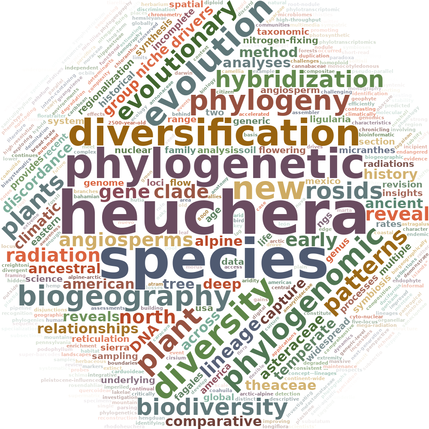Hybridization deep and shallow in Heuchera
Heuchera, a group of rock-growing plants native to North America, has some of the most frequent and complex hybridization events in plant lineages sundered by as much as 7 million years of divergence. We are using phylogenomic methods to assess species limits and hybridization at multiple levels of evolutionary differentiation, from populations up to fairly distant clades. We are also using paleoclimate data to reconstruct historical range contractions that may have driven hybridization in this group.
The evolution of nitrogen-fixing symbioses
Nitrogen-fixing symbioses, particularly in the form of root nodules, are major drivers in many terrestrial ecosystems. Remarkably, these evolutionary strategies are concentrated in one small branch of the plant tree of life. Commonalities and differences among multiple origins of the nodule organ, assessed at multiple levels from genes to ecology, will be highly relevant to crop improvement in non-fixing lineages.
We are interested in shedding light on the biodiversity and ecology of nitrogen-fixing symbioses using large-scale DNA and phenotype datasets. This work has been funded by NSF, DOE, and the University of Florida.
We are interested in shedding light on the biodiversity and ecology of nitrogen-fixing symbioses using large-scale DNA and phenotype datasets. This work has been funded by NSF, DOE, and the University of Florida.
Plant-microbe interactions
We have several projects in the lab focused on plant-microbe interactions. We are primarily interested in environment and host phylogenetic determinants of leaf and root microbiomes. We are working on projects focused on nitrogen-fixing plants as well as flora of the Southeast, and aiming to document how nitrogen-fixing bacteria assort into nodulating plant species.
Questions that we work on in this topic area include plant-microbe co-evolution and community composition over geographic areas and plant host species variation. If you are a student interested in plant-microbe interactions, contact us!
Questions that we work on in this topic area include plant-microbe co-evolution and community composition over geographic areas and plant host species variation. If you are a student interested in plant-microbe interactions, contact us!
Niche biology in the Saxifragales
The Saxifragales are an ancient, relatively isolated clade of angiosperms associated with the Rosids and Vitales, whose heterogeneous composition is one of the great surprises of plant molecular systematics. In comparison with other clades at this level, it is relatively modest in size but exhibits a vast diversity of habitats. For instance, in this group one finds desert succulents closely related to aquatic weeds, or forest dwellers near alpine cushion plants.
We have recently demonstrated the complex timing of species divergence and trait divergence in this group. Ongoing work is mapping the spatial pattern of the diversification process in a group exhibiting an essentially inverted biodiversity gradient.
We have recently demonstrated the complex timing of species divergence and trait divergence in this group. Ongoing work is mapping the spatial pattern of the diversification process in a group exhibiting an essentially inverted biodiversity gradient.
Photo: Heuchera pulchella
